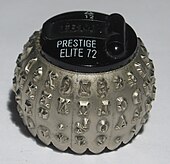
Back IBM Selectric Catalan Schreibmaschinen-Kugelkopf German IBM Selectric Spanish IBM Selectric Finnish Technique IBM à boule French आईबीएम सेलेक्ट्रिक Hindi IBM Selectric Italian IBM Selectric typewriter Japanese IBM Selectric NB IBM Selectric Portuguese
 IBM Selectric I | |
| Manufacturer | International Business Machines Corporation (IBM) |
|---|---|
| Type | Electric typewriter |
| Release date | 31 July 1961 |
| Predecessor | IBM Electric and Electromatic typewriters |
| Successor | IBM Wheelwriter |
| Related | IBM MT/ST and MT/SC, IBM MC (external storage options) |
The IBM Selectric (a portmanteau of "selective" and "electric") was a highly successful line of electric typewriters introduced by IBM on 31 July 1961.[1][2]

Instead of the "basket" of individual typebars that swung up to strike the ribbon and page in a typical typewriter of the period, the Selectric had an "element" (frequently called a "typeball", or less formally, a "golf ball") that rotated and pivoted to the correct position before striking the paper. The element could be easily interchanged to use different fonts within the same document typed on the same typewriter, resurrecting a capability which had been pioneered by typewriters such as the Hammond and Blickensderfer in the late 19th century.
The Selectric also replaced the traditional typewriter's horizontally-moving carriage with a roller (platen) that turned to advance the paper vertically while the typeball and ribbon mechanism moved horizontally across the paper. The Selectric mechanism was notable for using internal mechanical binary coding and two mechanical digital-to-analog converters, called whiffletree linkages, to select the character to be typed.
Selectrics and their descendants eventually captured 75 percent of the United States market for electric typewriters used in business.[3] By the Selectric's 25th anniversary, in 1986, a total of more than 13 million machines had been made and sold.[4]
By the 1970s and 1980s, the typewriter market had matured under the market dominance of large companies in Europe and the United States. Eventually the Selectric would face direct major competition from electronic typewriters designed and manufactured in Asia, including Brother Industries and Silver Seiko Ltd. of Japan.
IBM replaced the Selectric line with the IBM Wheelwriter in 1984, and transferred its typewriter business to the newly formed Lexmark in 1991.[5]
- ^ "History of the IBM Typewriter". etypewriters.com. 11 October 2016. Archived from the original on 5 July 2022. Retrieved 15 January 2017.
- ^ "Carriageless Typewriter Shown; New I.B.M. Selectric Can Accommodate Six Print Fonts". The New York Times. 1 August 1961.
An electric typewriter that eliminates type bars and movable carriages and that can use six interchangeable type faces was introduced by the International Business Machines Corporation yesterday ...
- ^ "Eliot Fette Noyes, FIDSA". Industrial Design Society of America--About ID. 13 April 2010. Retrieved 4 July 2024.
- ^ "IBM100 – The Selectric Typewriter". www-03.ibm.com. 7 March 2012. Archived from the original on 3 September 2018. Retrieved 3 September 2018.
- ^ "IBM Archives: IBM typewriter milestones - page 2". ibm.com. 23 January 2003. Archived from the original on 17 February 2017. Retrieved 15 January 2017.
© MMXXIII Rich X Search. We shall prevail. All rights reserved. Rich X Search